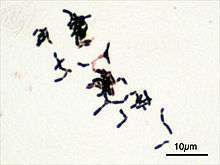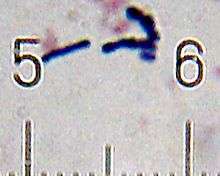Bifidobacterium
| Bifidobacterium | |
|---|---|
 | |
| Bifidobacterium adolescentis | |
| Scientific classification | |
| Domain: | Bacteria |
| Phylum: | Actinobacteria |
| Class: | Actinobacteria |
| Order: | Bifidobacteriales |
| Family: | Bifidobacteriaceae |
| Genus: | Bifidobacterium Orla-Jensen 1924 |
| Species | |
|
B. actinocoloniiforme[1] | |
| Synonyms[2] | |
| |
Bifidobacterium is a genus of gram-positive, nonmotile, often branched anaerobic bacteria. They are ubiquitous inhabitants of the gastrointestinal tract, vagina[3][4] and mouth (B. dentium) of mammals, including humans. Bifidobacteria are one of the major genera of bacteria that make up the gastrointestinal tract microbiota in mammals. Some bifidobacteria are used as probiotics.
Before the 1960s, Bifidobacterium species were collectively referred to as "Lactobacillus bifidus".
History

In 1899, Henri Tissier, a French pediatrician at the Pasteur Institute in Paris, isolated a bacterium characterised by a Y-shaped morphology ("bifid") in the intestinal microbiota of breast-fed infants and named it "bifidus".[5] In 1907, Élie Metchnikoff, deputy director at the Pasteur Institute, propounded the theory that lactic acid bacteria are beneficial to human health.[5] Metchnikoff observed that the longevity of Bulgarian peasants was the result of their consumption of fermented milk products.[6] Elie Metchnikoff also suggested that “oral administration of cultures of fermentative bacteria would implant the beneficial bacteria in the intestinal tract”.[7]
Metabolism
The genus Bifidobacterium possesses a unique fructose-6-phosphate phosphoketolase pathway employed to ferment carbohydrates.
Much metabolic research on bifidobacteria has focused on oligosaccharide metabolism, as these carbohydrates are available in their otherwise nutrient-limited habitats. Infant-associated bifidobacterial phylotypes appear to have evolved the ability to ferment milk oligosaccharides, whereas adult-associated species use plant oligosaccharides, consistent with what they encounter in their respective environments. As breast-fed infants often harbor bifidobacteria-dominated gut consortia, numerous applications attempt to mimic the bifidogenic properties of milk oligosaccharides. These are broadly classified as plant-derived fructooligosaccharides or dairy-derived galactooligosaccharides, which are differentially metabolized and distinct from milk oligosaccharide catabolism.[4]
Response to oxygen
The sensitivity of members of the genus Bifidobacterium to O2 generally limits probiotic activity to anaerobic habitats. Recent research has reported that some Bifidobacterium strains exhibit various types of oxic growth. Low concentrations of O2 and CO2 can have a stimulatory effect on the growth of these Bifidobacterium strains. Based on the growth profiles under different O2 concentrations, the Bifidobacterium species were classified into four classes: O2-hypersensitive, O2-sensitive, O2-tolerant, and microaerophilic. The primary factor responsible for aerobic growth inhibition is proposed to be the production of hydrogen peroxide (H2O2) in the growth medium. A H2O2-forming NADH oxidase was purified from O2-sensitive Bifidobacterium bifidum and was identified as a b-type dihydroorotate dehydrogenase. The kinetic parameters suggested that the enzyme could be involved in H2O2 production in highly aerated environments.[8]
Genomes
Members of the genus Bifidobacterium have genome sizes ranging from 1.73 (Bifidobacterium indicum) to 3.25 Mb (Bifidobacterium biavatii), corresponding to 1,352 and 2,557 predicted protein-encoding open reading frames, respectively.[9]
Functional classification of Bifidobacterium genes, including the pan-genome of this genus, revealed that 13.7% of the identified bifidobacterial genes encode enzymes involved in carbohydrate metabolism.[9]
Clinical uses
Adding bifidobacterium as a probiotic to conventional treatment of ulcerative colitis has been shown to be associated with improved rates of remission and improved maintenance of remission.[10] Some Bifidobacterium strains are considered as important probiotics and used in the food industry. Different species and/or strains of bifidobacteria may exert a range of beneficial health effects, including the regulation of intestinal microbial homeostasis, the inhibition of pathogens and harmful bacteria that colonize and/or infect the gut mucosa, the modulation of local and systemic immune responses, the repression of procarcinogenic enzymatic activities within the microbiota, the production of vitamins, and the bioconversion of a number of dietary compounds into bioactive molecules.[4] Bifidobacteria improve the gut mucosal barrier and lower levels of lipopolysaccharide in the intestine.[11]
Naturally occurring Bifidobacterium spp. may discourage the growth of Gram-negative pathogens in infants.[12]
Mother's milk contains high concentrations of lactose and lower quantities of phosphate (pH buffer). Therefore, when mother's milk is fermented by lactic acid bacteria (including bifidobacteria) in the infant's gastrointestinal tract, the pH may be reduced, making it more difficult for Gram-negative bacteria to grow.
See also
References
- 1 2 3 4 5 6 7 8 9 10 11 12 13 14 15 16 17 18 19 20 21 22 23 Parte, A.C. "Bifidobacterium". Www.bacterio.net.
- ↑ Darusman, H.S.; Rahminiwati, M.; Sadiah, S.; Batubara, I.; Darusman, L.K.; Mitsunaga, T. (2 November 2011). "Indonesian Kepel Fruit (Stelechocarpus burahol) as Oral Deodorant". Research Journal of Medicinal Plants. 6 (2): 180–188. doi:10.3923/rjmp.2012.180.188. ISSN 1819-3455. OCLC 761052058. Retrieved 1 March 2018.
- ↑ Schell, Mark A.; Karmirantzou, Maria; Snel, Berend; Vilanova, David; Berger, Bernard; Pessi, Gabriella; Zwahlen, Marie-Camille; Desiere, Frank; et al. (2002). "The genome sequence of Bifidobacterium longum reflects its adaptation to the human gastrointestinal tract". Proceedings of the National Academy of Sciences of the United States of America. 99 (22): 14422–7. doi:10.1073/pnas.212527599. PMC 137899. PMID 12381787.
- 1 2 3 Mayo, Baltasar; van Sinderen, Douwe, eds. (2010). Bifidobacteria: Genomics and Molecular Aspects. Caister Academic Press. ISBN 978-1-904455-68-4.
- 1 2 "Potential of probiotics as biotherapeutic agents targeting the innate immune system" (PDF). African Journal of Biotechnology. February 2005.
- ↑ "Probiotics: 100 years (1907–2007) after Elie Metchnikoff's Observation" (PDF). Communicating Current Research and Educational Topics and Trends in Applied Microbiology. February 2007. Archived from the original (PDF) on 2012-10-04.
- ↑ "Pioneers of Probiotics". European Probiotic Association. February 2012.
- ↑ Sonomoto, Kenji; Yokota, Atsushi, eds. (2011). Lactic Acid Bacteria and Bifidobacteria: Current Progress in Advanced Research. Caister Academic Press. ISBN 978-1-904455-82-0.
- 1 2 Milani, Christian; Turroni, Francesca; Duranti, Sabrina; Lugli, Gabriele Andrea; Mancabelli, Leonardo; Ferrario, Chiara; van Sinderen, Douwe; Ventura, Marco (15 February 2016). "Genomics of the Genus Bifidobacterium Reveals Species-Specific Adaptation to the Glycan-Rich Gut Environment". Applied and Environmental Microbiology. 82 (4): 980–991. doi:10.1128/AEM.03500-15. ISSN 1098-5336. PMC 4751850. PMID 26590291.
- ↑ Ghouri, Yezaz A; Richards, David M; Rahimi, Erik F; Krill, Joseph T; Jelinek, Katherine A; DuPont, Andrew W (9 December 2014). "Systematic review of randomized controlled trials of probiotics, prebiotics, and synbiotics in inflammatory bowel disease". Clin Exp Gastroenterol. 7: 473–487. doi:10.2147/CEG.S27530. PMC 4266241. PMID 25525379.
- ↑ Pinzone, MR.; Celesia, BM.; Di Rosa, M.; Cacopardo, B.; Nunnari, G. (2012). "Microbial translocation in chronic liver diseases". Int J Microbiol. 2012: 694629. doi:10.1155/2012/694629. PMC 3405644. PMID 22848224.
- ↑ Lievin, V (1 November 2000). "Bifidobacterium strains from resident infant human gastrointestinal microflora exert antimicrobial activity". Gut. 47 (5): 646–652. doi:10.1136/gut.47.5.646.
External links
- Bifidobacterium at Microbe Wiki
- Genomes Online Database contains many Bifidobacterium genome projects
- Comparative Analysis of Bifidobacterium Genomes (at DOE's IMG system)
- Bifidobacterium at BacDive - the Bacterial Diversity Metadatabase
| Wikispecies has information related to Bifidobacterium |
